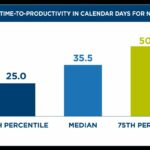In today’s interconnected world, the boundaries between personal and professional lives have become increasingly blurred. As a result, the once traditional methods of evaluating outplacement metrics have become outdated and insufficient. With the rapid rise of social media platforms, it is crucial for organizations to adapt their measurement techniques and embrace online engagement as a means of assessing the efficacy of their outplacement efforts. This article delves into the fascinating relationship between outplacement metrics and social media, exploring the potential for gauging online engagement and its impact on career transitions. By delving into this captivating connection, we can unlock a powerful tool to measure success in the ever-evolving landscape of outplacement. So, let us embark on this journey of evaluation, analysis, and discovery in the realm of outplacement metrics and social media engagement.
1. Sparking Success: Unveiling the Hidden Power of Outplacement Metrics and Social Media
Outplacement Metrics: Measuring Success
Outplacement metrics are essential tools for evaluating the effectiveness and success of the outplacement process. Gone are the days when outplacement was viewed as a mere checkbox on the HR to-do list. With the advent of sophisticated tracking software and data analytics, organizations can now delve deeper into the impact of outplacement and determine its true value.
- Quantitative Metrics: Tracking the number of employees who secure new positions within a specific timeframe is one of the most crucial metrics. This data provides tangible evidence of outplacement success and indicates the effectiveness of the program.
- Qualitative Metrics: Measuring employee satisfaction and feedback through surveys and interviews helps gauge the overall impact of outplacement. By analyzing qualitative metrics, organizations can identify areas of improvement and better tailor their outplacement strategies to meet individual needs.
- Cost Metrics: Calculating the financial ROI of outplacement efforts is vital for organizations. By quantifying the cost savings resulting from reduced severance pay and unemployment claims, companies can justify their investment in outplacement services.
Social Media: Unleashing Opportunities
Social media has revolutionized the way we communicate, engage, and find opportunities. In the realm of outplacement, it has become an invaluable resource for both job seekers and organizations. Leveraging social media platforms allows job seekers to expand their network, showcase their skills and accomplishments, and uncover hidden job opportunities. On the other hand, companies are leveraging social media to identify potential candidates, engage with talent communities, and enhance their employer brand.
- Networking Opportunities: Social media platforms like LinkedIn offer expansive networking opportunities, enabling job seekers to connect with professionals across industries, uncover job leads, and gain industry insights.
- Showcasing Expertise: Through social media, individuals can showcase their expertise, share thought leadership articles, and contribute to relevant discussions – positioning themselves as industry experts and attracting prospective employers.
- Brand Building: Organizations can leverage platforms like Facebook, Twitter, and Instagram to build their employer brand, sharing company culture and values, highlighting employee success stories, and attracting top talent.
2. Navigating the Uncharted Waters: A Deep Dive into Measuring Online Engagement in Outplacement Services
In today’s digital age, the world of outplacement services is evolving at a rapid pace. As organizations increasingly turn to online platforms to provide support to their employees during career transitions, measuring online engagement has become a critical factor in assessing the effectiveness of these services. This deep dive will delve into the uncharted waters of measuring online engagement in outplacement services, exploring innovative strategies and tools that can help organizations navigate this complex landscape.
One key aspect to consider when measuring online engagement is the analysis of user interactions. By tracking how users navigate through the online platform, organizations can gain valuable insights into their engagement levels. Metrics such as time spent on various pages, click-through rates, and completion rates can provide a comprehensive picture of how users are engaging with the outplacement content. This information can help organizations identify areas where users are actively involved and where they may be experiencing difficulties or disengagement.
3. Unleashing the Digital Potential: Outplacement Metrics and Social Media as Catalysts for Career Transition
Transitioning careers can be a daunting process, but with the advent of digital technologies and the power of social media, individuals can now unlock a wealth of opportunities like never before. Embracing this digital potential is crucial for successful career transitions in today’s fast-paced world.
Outplacement Metrics: Tracking and measuring the effectiveness of outplacement programs can provide invaluable insights for both individuals and organizations. Through the use of data analytics, professionals can gain a deeper understanding of the impact of outplacement services on career transition outcomes. Metrics such as job placement rates, time taken to secure new employment, and satisfaction levels can help identify areas of improvement and tailor support to individual needs. By leveraging outplacement metrics, individuals can gauge their progress and adjust their strategies accordingly, while employers can fine-tune their initiatives for maximum success.
Social Media as Catalyst: The rise of social media platforms has revolutionized the way we connect and communicate, making them indispensable tools for career transition. LinkedIn, for instance, allows individuals to showcase their skills, connect with professionals, and access industry insights. By creating a compelling digital presence and engaging with relevant communities, job seekers can establish their credibility and expand their network exponentially. Similarly, other platforms like Twitter, Facebook, and professional forums offer unique avenues for personal branding, learning opportunities, and accessing hidden job markets. Harnessing the power of social media can significantly enhance career transition prospects by opening doors to new possibilities and amplifying one’s professional image.
4. Connecting the Dots: Unveiling the Relationship between Online Engagement and Successful Outplacement
In today’s rapidly changing job market, successful outplacement demands a deep understanding of the evolving dynamics between online engagement and career transitions. Connecting the dots between these two essential components has become paramount for professionals seeking to navigate the complexities of finding new employment opportunities.
Online engagement platforms offer unparalleled access to a vast array of resources and tools that are crucial for job seekers during the outplacement process. These platforms provide a convenient space for individuals to connect with industry professionals, gain insights on current market trends, and access robust databases of job listings. Additionally, the integration of interactive online coaching and training sessions empowers individuals to upskill, build an effective personal brand, and craft tailored resumes and cover letters that stand out to potential employers. Through harnessing the power of online engagement, individuals undergoing outplacement can proactively position themselves for success in a competitive job market.
In this era of digital dominance and virtual connectivity, the importance of effective outplacement strategies cannot be overstated. As HR professionals and businesses grapple with the challenges presented by the ever-evolving job market, leveraging social media platforms has become an indispensable tool in evaluating online engagement. The convergence of outplacement metrics and social media has opened up a world of possibilities for recruiters, job seekers, and employers alike.
Through comprehensive analysis of online engagement, employers can gauge the impact of their outplacement strategies with unparalleled precision. With every click, like, and comment, a story unfolds – a narrative that can guide HR professionals towards informed decisions and targeted interventions. By tapping into the vast pool of data made available by social media platforms, businesses can effectively measure the success of their outplacement efforts, ensuring maximum impact and return on investment.
However, this marriage between outplacement metrics and social media is not without its challenges. The pervasive nature of social media can blur the boundaries between personal and professional identities, requiring a delicate balance when it comes to privacy and data handling. HR professionals must navigate through these ethical and legal complexities to ensure that online engagement is evaluated responsibly and respectfully.
Yet, the benefits are undeniable. By harnessing the power of social media, outplacement metrics provide valuable insights into the effectiveness of recruitment strategies, enabling HR professionals to fine-tune their approaches. Job seekers, too, can benefit from online engagement evaluation, identifying areas for improvement and honing their personal brand to attract potential employers. Moreover, employers can gain a competitive edge by understanding the shifting dynamics of the digital landscape, allowing them to adapt and innovate to meet the demands of a changing workforce.
In conclusion, the integration of outplacement metrics and social media in evaluating online engagement represents a paradigm shift in recruitment practices. It offers a wealth of opportunities to HR professionals and businesses seeking to optimize their outplacement strategies. By embracing this digital revolution and handling data responsibly, we can unlock a world of insights and possibilities, ultimately reshaping the way towards a brighter future for both job seekers and employers.








